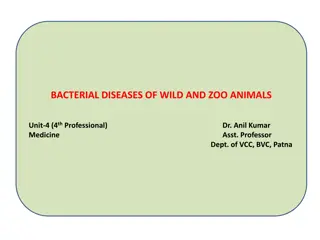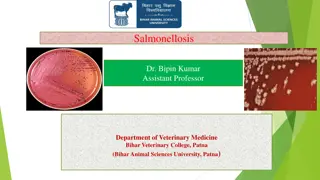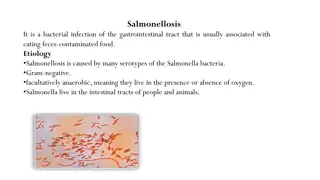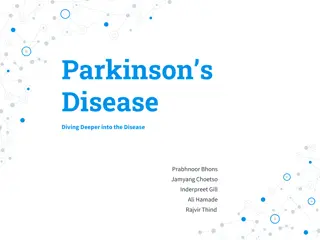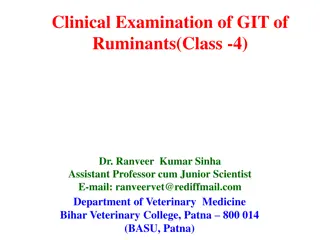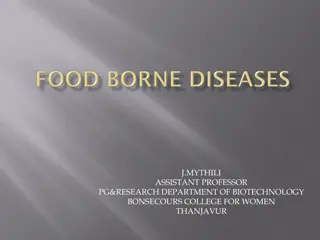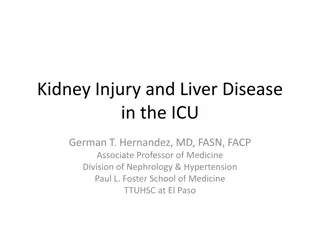Salmonellosis: Understanding the Disease and Its Implications
Salmonellosis is a bacterial infection caused by various serotypes of the Salmonella bacteria. The disease is transmitted through contaminated food, direct contact with infected animals, or the fecal-oral route in endemic areas. Typhoidal Salmonella serovars can lead to serious conditions like enteric fever. Understanding the morphology, transmission, and symptoms of Salmonellosis is crucial for prevention and management.
Download Presentation

Please find below an Image/Link to download the presentation.
The content on the website is provided AS IS for your information and personal use only. It may not be sold, licensed, or shared on other websites without obtaining consent from the author. Download presentation by click this link. If you encounter any issues during the download, it is possible that the publisher has removed the file from their server.
E N D
Presentation Transcript
Introduction Family: Enterobateriaceae Named by: D.E. Salmon, Isolated Salmonella Choleraesuis, from pigs in 1885 (Le Minor.,1994) Morphology: Rod-shaped (dia. 0.7 to 1.5 m/ length 2 to 5 m) Gram-negative Non-spore forming, Predominantly motile (except S. Gallinarum and S. Pullorum) Having peritrichous flagella Recognized species: Two S. enterica S. bongori
Introduction Number of serotypes: More than 2650 (According to the Kauffmann-White (KW) scheme) Salmonella enterica (2639) Salmonella bongori (20) (Ryan et al., 2017) The basis of K-W serotyping includes O (Heat-stabile somatic) Vi (Heat-labile capsular) H (Flagellar) antigens (Nataro et al., 2011) S. enterica subsp. Enterica: 1586 serotypes of which S. Typhimurium and S. Enteritidis are mainly responsible for human infections
Introduction S. enterica subsp. salamae (522), subsp. arizonae (102), subsp. diarizonae (308), subsp. houtenae (76) and subsp. indica (13) serotypes (Grimont and Weill., 2007) S. bongori (V) composed of 22 serotypes Mainly associated with cold-blooded animals Role in human infections are very uncommon May affect children of 1 month to 3 years of age (Giammanco et al., 2002) Nomenclature: The full taxonomic designation can be shortened by writing the genus name & name of serovar or serotype with First letter caps & without underline or italic (Eg. Salmonella enterica subspecies enterica serotype Typhimurium as Salmonella Typhimurium) (According to CDC & WHO)
Source of infection and mode of transmission Isolated from: wide range of animals & their food products (Poultry, bovine, ovine, porcine, fish, seafood & poikilotherms (cold- blooded animals) such as lizards & snakes (Zajac et al., 2013: Nguyen et al., 2016; Flockhart et al., 2017) Infection: Non-typhoidal Salmonella Ingestion of contaminated foods with bacteria: eggs, chicken, beef, pork, milk products, fruits, & vegetables Direct person to person contact Contact with infected animals farm or cats, dogs, rodents, reptiles, or amphibians (Haeusler and Curtis., 2013) Typhoidal Salmonella Endemic: Developing world Area with lack of clean water & adequate sanitation Transmit through the fecal-oral route
Disease in human Typhoidal Salmonella serovars Enteric fever -typhoid (Salmonella serovars serovar Typhi) Paratyphoid fever (Salmonella serovars Paratyphi) Incubation period: 14 day Symptoms Gradual onset of sustained fever (39 40 C), Chills, Abdominal pain, Hepatosplenomegaly, Rash (rose spots), Nausea, Anorexia, Diarrhea or constipation, Headache, & a dry cough
Disease in human Non Typhoidal Salmonella (NTS) serovars Cause self-limiting, acute gastroenteritis & watery diarrhea Incubation Period: 6 12 h which lasts within 10 days The most common symptoms Diarrhoea Nausea Vomition, Abdominal pain Fever In immunocompromised patient shows Invasive infections Symptoms similar to enteric fever characterized by high fever, hepatosplenomegaly & respiratory complications
Disease in animals Cattle: Caused by : S. Dublin & S. Typhimurium Clinical salmonellosis along with isolation of some other serotypes from infected animals In adult Source of infection: faeces & milk of an infected cow Symptoms: High fever, abdominal pain, faeces with blood clots, followed by profuse diarrhoea & finally sub normal body temperature In pregnant cattle : shows abortion The outcome of disease: Death within a few days/ recovery /carrier Calves More susceptible high mortality Caused septicaemia & death of new-born calves
Disease in animals Swine: Principal reservoir of S. Choleraesuis Other serotypes: S. Enteritidis, S. Typhimurium, & S. Dublin Source of infections: The carrier animals & contaminated food Causes: Swine paratyphoid or necrotic enteritis Highly susceptible: in 2 to 4 months of age Symptoms Fever & diarrhoea Invasive infections leads to septicaemia blood or any organ such as intestine & mesenteric lymph nodes
Disease in animals Sheep and Goats: S. Typhimurium & other serotypes: Gastroenteritis S.Abortusovis: Gastroenteritis, Abortions in last two months of pregnancy, Stillbirths in pregnant ewes Mortality in neonates
Disease in animals Horses and Donkey: S.Abortusequi In mares & donkeys:Abortion (7-8 month of pregnancy) Stallion: Fever, Edematous swelling of the prepuce, Hydrocele, epididymitis, Orchitis, Testicular atrophy and arthritis Equines are also susceptible to other serotypes particularly S. Typhimurium
Disease in animals Dogs and Cats: infected asymptomatic carriers They may get infection by consumption of faecal materials of other animals or man, and contaminated food and may suffer from gastroenteritis by various serotypes of Salmonella and acts as
Disease in animals Fowl: Caused disease by: S. Pullorum & S. Gallinarum Host: Mainly chickens & turkeys Other birds: pheasants, quail, ducks, guinea-fowl & peafowl Potent reservoirs: Domestic poultry Disease S. Pullorum: Pullorum disease (effect young bird: 2-4 month) S. Gallinarum: fowl typhoid (adult bird)
Disease in animals Pullorum disease Transmit vertically & horizontally The birds may manifest depression, anorexia, huddling, droopy wings, dehydration, laboured breathing, diarrhoea, ruffled feathers, weakness & adherence of faeces to the vent
Diagnosis Diagnosis of Salmonella serovars may be performed by 1. Cultural method 2. Serotyping 3. Molecular tools
Diagnosis Cultural method Gold standard Samples: stool, blood, bone marrow, urine etc while faecal and food samples (NTS) Pre-enrichment: Buffered peptone water Enrichment: Selenite cystine broth or Tetrathionate broth Selective/differential/chromogenic media: MacConkey, Hektoen enteric (HE), Xylose-lysine-deoxycholate (XLD), Salmonella-shigella (SS), Bismuth sulfite agar (BSA) Brilliant green & CHROM agar (Gal-Mor., 2018)
BSA BGA HE XLD
Diagnosis Biochemical characterization Test Indole Methyl red Voges-Proscauer Citrate utilization Urease test TSI reaction - ve +ve - ve +ve - ve Acidic butt and alkaline slant with blackening
Diagnosis Serotyping Carried out at central reference laboratories (K W scheme) 1. National Salmonella and Escherichia Centre (NSEC), Central Research Institute, Kasauli (H.P) 173204 (India) 2. National Salmonella centre, ICAR-IVRI, Izatnagar, Bareilly (UP), 243122 Molecular Typing Pulsed-field gel electrophoresis (PFGE), Multilocus sequence typing (MLST), Ribotyping, Clustered regularly interspaced short palindromic repeat (CRISPR) (Gal-Mor., 2018)
Diagnosis Serological Diagnosis Widal tube agglutination test Dot blot enzyme-linked immunosorbent assay (ELISA) Enzyme immunoassay (EIA) Molecular and other method PCR-based assays targeting invA, hisJ, hilA, fliC, viaB, ttrC- ttrA, 23S rRNA ratA etc. Some other techniques MALDI-TOF MS Whole-genome sequencing
Prevention and control In human By reduction of its prevalence in food animals Proper expert inspection/ supervision: Meat, milk & egg production Education: Farmers, milkers, butchers & animal food handlers: about basic concept of food, slaughter, personal & environmental hygiene Producers & consumers: Proper cooking & refrigeration practices Epidemiological surveillance To evaluate the magnitude of problem, origins of outbreaks & to design suitable measures to reduce the risks
Prevention and control In animals Elimination of carriers, Immunization Proper management of herds & poultry farms.




